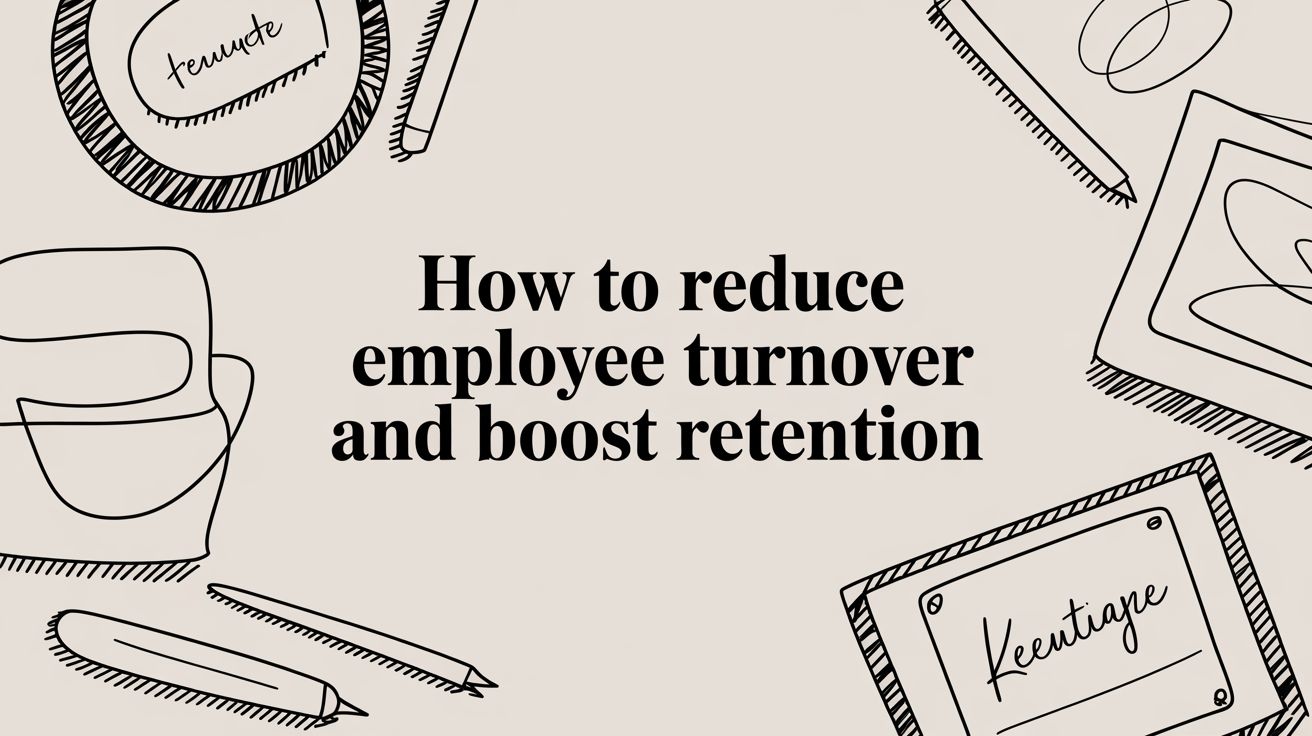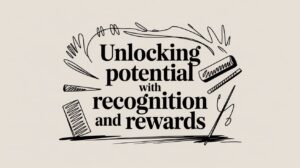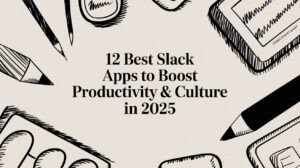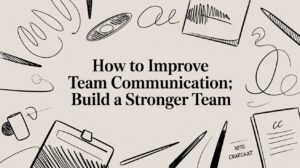If you want to reduce employee turnover seriously, you can’t just throw solutions at the wall and hope something sticks. You need a comprehensive game plan that gets to the heart of why people leave. This means focusing on better hiring practices, empowering your managers, offering fair compensation with clear paths for growth, and building a strong culture of recognition.
Table of Contents
This isn’t about scrambling to fill roles. It’s about creating a proactive system that makes your best people want to stay.
The True Cost of a Revolving Door
High employee turnover is more than just an inconvenient HR metric. It’s a silent killer of productivity, morale, and the institutional knowledge that keeps your business running smoothly. The obvious costs—recruitment fees, job board ads, interview hours—are just the tip of the iceberg. The real damage is happening beneath the surface, slowly eroding your company’s foundation.
When someone leaves, the team feels it immediately. Projects stall, deadlines get pushed, and the remaining employees are left to pick up the slack, which is a fast track to burnout. This can create a domino effect, where one person’s departure leads to another as the rest of the team becomes disengaged and overwhelmed.
Understanding the Financial and Cultural Damage
The financial hit from turnover can be staggering. On average, replacing an employee costs about 20% of their annual salary. For senior leaders or highly specialized roles, that number can balloon to an eye-watering 210%. These figures make it painfully clear just how valuable retaining your key talent really is.
For a deeper dive into the numbers, this guide on the cost of employee turnover breaks it down completely.
But the damage isn’t just financial. Constant churn destroys team cohesion and erodes the trust that’s essential for collaboration. Every time an employee walks out the door, they take a piece of your institutional knowledge with them—all that undocumented expertise about your processes, clients, and history. Rebuilding that loss can take months, if not years.
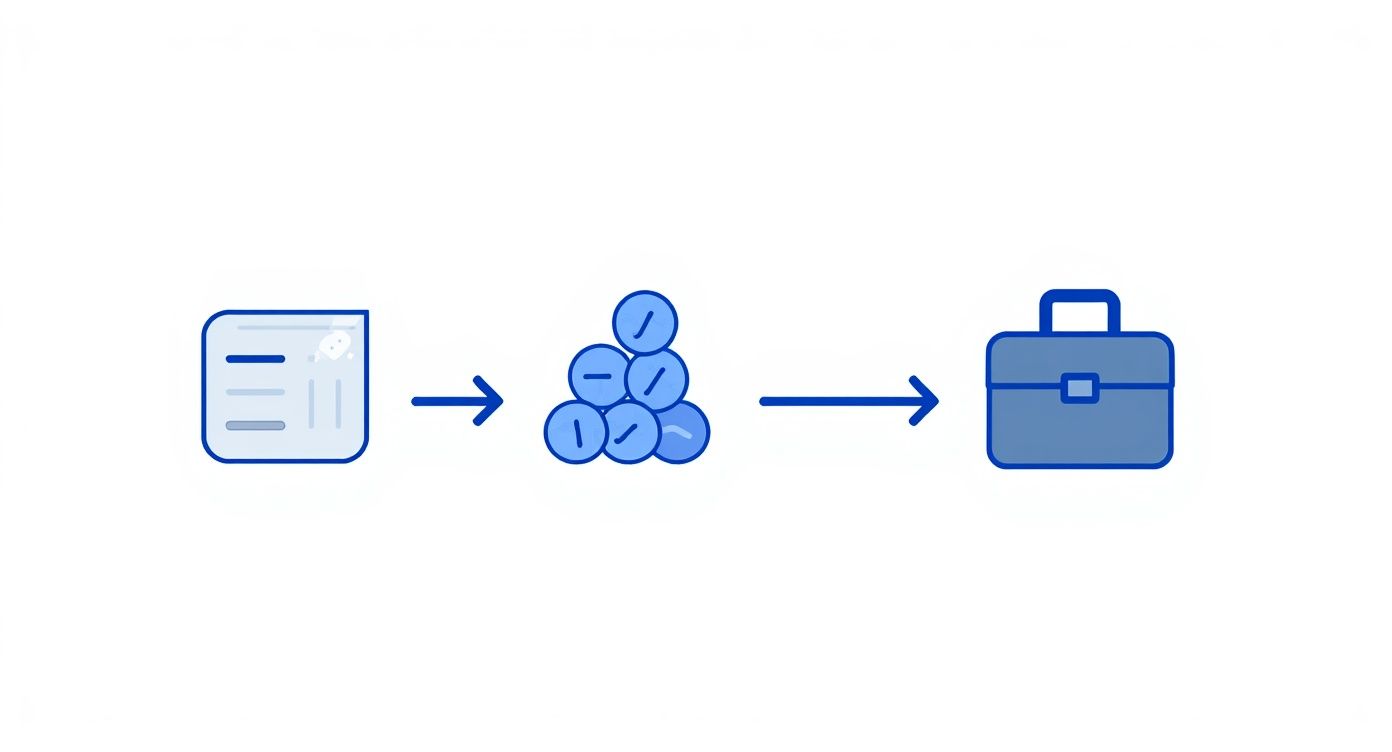
The first step is always to calculate your turnover rate. From there, you can assess the full financial and cultural impact, providing everything you need to build a compelling business case for investing in retention.
Core Pillars of a Modern Retention Strategy
To help you get started, this table outlines the foundational strategies we’ll be covering. Think of it as your at-a-glance guide to building a workplace where people are loyal, engaged, and excited to contribute.
| Strategy Pillar | Primary Goal | Example Tactic |
|---|---|---|
| Hiring & Onboarding | Attract the right people and set them up for long-term success from day one. | Implement a structured 90-day onboarding plan with clear milestones. |
| Manager Development | Equip managers with the skills to lead, coach, and support their teams effectively. | Provide ongoing training on giving constructive feedback and recognition. |
| Compensation & Career Paths | Ensure fair pay and show employees a clear future within the company. | Create transparent salary bands and visible career progression ladders. |
| Recognition & Culture | Foster a positive environment where employees feel seen, valued, and appreciated. | Integrate a peer-to-peer recognition tool (like AsanteBot) into daily workflows. |
Each of these pillars works together to create an environment that not only attracts top talent but also convinces them to build a career with you.
The Role of Recognition in Stemming the Tide
One of the most potent—and frequently overlooked—tools in your retention toolkit is simple recognition. When people feel seen and valued for their contributions, their connection to the company deepens in a way that money alone can’t buy. This isn’t about the annual bonus; it’s about the daily, consistent acknowledgment that their work matters. The importance of team recognition lies in its ability to build psychological safety and a strong sense of belonging. It reinforces positive behaviors and shows everyone what success looks like in your culture.
A strong culture of appreciation creates emotional capital. It builds a sense of belonging and psychological safety that makes employees far less likely to be swayed by a slightly higher salary offer from a competitor.
Here’s what that looks like in the real world.
Imagine a marketing team just wrapped a huge campaign launch. Instead of a generic “good job” in the next team meeting, the manager jumps into a public Slack channel and gives specific praise. They shout out the content writer for their killer copy, the designer for the stunning visuals, and the analyst for the data insights that guided the whole strategy.
This small act took two minutes, but it validated individual efforts, reinforced the exact behaviors you want to see more of, and boosted the entire team’s morale. That’s the kind of thing that makes people stick around.
Hire for Longevity, Not Just the Role
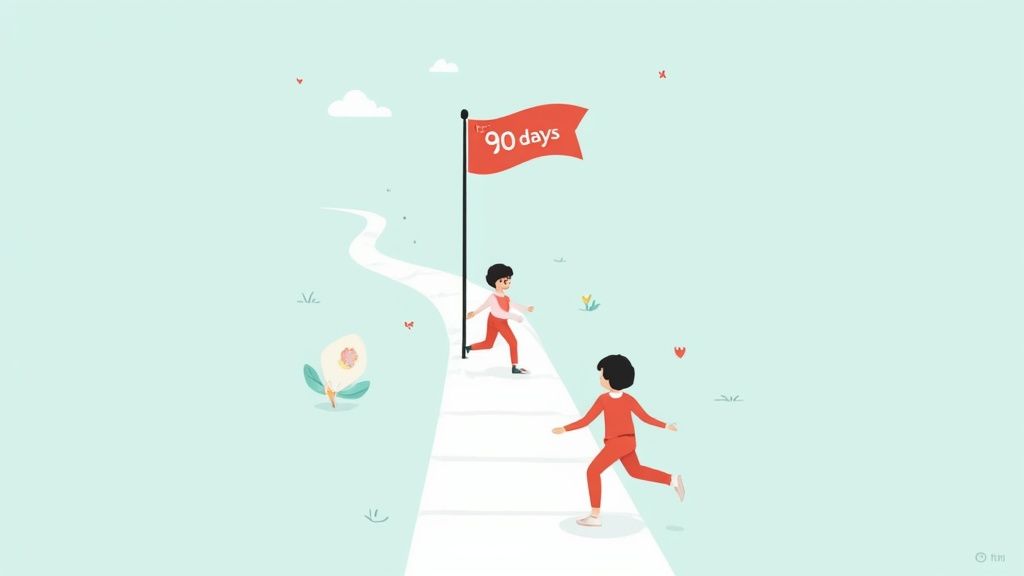
Great retention doesn’t start when someone is thinking about leaving. It starts before you even send them an offer letter.
All too often, hiring managers get laser-focused on hard skills and a candidate’s resume. They’re trying to plug a hole, fast. This transactional approach is exactly why so many new hires quietly quit within their first year, a classic case of “new hire remorse.”
If you’re serious about reducing turnover, you need a fundamental shift in how you hire. Stop just filling a seat. Start looking for people who are truly aligned with your company for the long haul—people who share your values, demonstrate resilience, and fit your culture.
Moving Beyond the Standard Interview
Let’s be honest, those classic interview questions like “What are your weaknesses?” are tired and don’t tell you much. To really understand a candidate, you have to dig deeper with behavioral and situational questions. You want to see how they think, solve problems, and handle themselves when things get tough.
It’s simple: instead of asking what they would do, ask what they have done.
- Tired Question: “How do you handle conflict?”
- Better Question: “Tell me about a time you had a major disagreement with a coworker. What was the situation, how did you handle it, and what was the result?”
- Practical Example: Ask a sales candidate, “Walk me through a time you lost a deal you were sure you were going to win. What did you learn from it?” This reveals their resilience and ability to self-assess far better than a hypothetical question.
This small change forces candidates to pull from real-life experience, giving you a much clearer window into their soft skills and emotional intelligence. Past behavior is one of the best predictors of future performance.
Crafting a Winning 90-Day Onboarding Plan
The first three months are make-or-break. A chaotic “sink or swim” onboarding experience is one of the fastest ways to lose a great new hire. A well-thought-out 90-day plan, on the other hand, gives them the clarity and confidence they need to succeed from the get-go.
Think of it as a roadmap, not just an HR checklist. It should nail three key areas:
- Role Clarity and Early Wins: Make their responsibilities crystal clear and define what success looks like. Give them a few small, manageable projects they can knock out in the first couple of weeks. Nothing builds momentum like an early win.
- Building Connections: Don’t leave networking to chance. Proactively schedule coffee chats with key people across different departments so they can start building their internal network and understanding how the business really works.
- Cultural Immersion: Don’t just hand them a values poster. Show them your culture in action. Include them in team rituals, explain the unwritten rules, and point out how your values show up in everyday decisions.
A well-executed onboarding process can improve employee retention by a staggering 82%. It’s your best shot at confirming they made the right choice in joining your team.
Practical Onboarding Examples That Work in Reducing Employee Turnover
Let’s get practical. Here are two potent yet simple tactics you can use to make your onboarding process truly special.
1. The Buddy System
This one is a game-changer. Pair your new hire with a tenured, positive employee who can guide them through the process. This “buddy” isn’t their manager; they’re a friendly guide for all the informal stuff.
- The Buddy’s Role: They help the new person navigate Slack channels, introduce them to people at lunch, and explain all the company acronyms. Most importantly, they answer the “stupid” questions the new hire might be too intimidated to ask their boss.
- Why It Works: It provides the new employee with an immediate social connection, which is huge for alleviating the first-week feeling of isolation. For example, the buddy can explain unwritten rules, like “We usually avoid scheduling meetings on Friday afternoons to give everyone focus time.”
2. The 30-60-90 Day Goal Framework
This framework provides much-needed structure by breaking the onboarding journey into three distinct phases, each with clear, measurable goals. It gives the new hire a sense of direction and makes it easy for their manager to provide targeted support.
- First 30 Days (Learning): The goal here is to absorb information. They should learn about the company, its culture, the tools, and key players. A practical goal might be: “Complete all required training modules and meet with the heads of five key departments.”
- Next 60 Days (Contributing): They now start applying that knowledge to initial projects, taking on more responsibility, and actively contributing to team goals. An example goal could be: “Successfully manage one small-scale project from start to finish.”
- Final 90 Days (Initiating): By now, the employee should be fully up to speed, taking initiative, and even suggesting improvements. A great goal here is: “Identify and present one process improvement suggestion for the team.”
When you invest this kind of thought into your hiring and onboarding, you’re not just filling a role—you’re laying the foundation for a long-term, successful team member. It’s the most proactive step you can take to stop turnover before it even starts.
Turn Your Managers into Retention Catalysts
You’ve heard it a million times: “People don’t leave companies, they leave managers.” It’s a cliché because it’s true. No amount of free snacks or inspiring mission statements can fix the daily reality of working for a bad boss. But a great manager? They’re your secret weapon against turnover.
A great manager inspires loyalty, keeps people engaged, and can single-handedly convince someone to stay. If you aren’t actively developing your leaders, you’re basically gambling with your retention rates. Investing in your managers isn’t just a nice perk; it’s a core business strategy that turns them from task-checkers into genuine coaches and mentors.
Building Your Manager Training Playbook
An effective training program has to be more than just theory. Managers need practical, real-world skills they can use tomorrow. Think of it as giving them a playbook for the tough situations they face every single day.
Your program should be built on a few non-negotiable pillars:
- Delivering Constructive Feedback: This involves teaching managers to provide specific, actionable, and, frankly, kind feedback. The goal is to build people up, not tear them down. Instead of saying, “Your reports are sloppy,” a well-trained manager says, “I noticed a few data inconsistencies in the Q3 report. Let’s walk through your process together so we can nail the next one.”
- Running Meaningful One-on-Ones: These meetings are for the employee, not just a status update for the manager. Train your leaders to ask real coaching questions. Things like, “What’s one thing we could change to make your work more engaging?” or “What roadblocks can I help you clear this week?”
- Supporting Career Growth: Every employee wants to know they have a future with you. Managers need to be comfortable having regular career conversations, helping their team members map out their goals, and finding them opportunities—such as a new project or a mentor—to build the skills they need to achieve their objectives.
Navigating Difficult Conversations
Let’s see how this works in the real world. A skilled manager can turn a conversation that could easily go south into a moment that actually fosters loyalty.
Imagine a top performer requests a permanent remote work arrangement, but it’s against the company’s current policy.
An untrained manager’s gut reaction might be a flat “Sorry, that’s not possible.” The employee feels dismissed and probably starts updating their LinkedIn profile. A trained manager, on the other hand, views this as a problem to be solved together. They might say, “I completely understand why you’re asking, and I want to find a way to support you. Could a hybrid schedule work? Let’s build a proposal we can take to leadership, focusing on how we’ll guarantee productivity and team connection.”
That simple shift in approach shows the employee they’re valued and that their manager is in their corner. That’s how you keep great people.
Making Recognition an Effortless Habit
One of the most powerful skills a manager can have is the ability to recognize their team’s contributions consistently. When people feel seen and appreciated, their commitment skyrockets. The problem is, when things get busy, recognition is often the first thing that gets forgotten. Recognizing your team isn’t just about morale; it’s about reinforcement. When you publicly praise someone for collaborating well, you’re telling the entire team, “This is what we value here.”
This is why you have to weave recognition into their daily workflow. It shouldn’t feel like another task on their to-do list; it should be as easy as sending a Slack message.
According to Gallup, employees who do not feel adequately recognized are twice as likely to say they’ll quit in the next year. This isn’t a “nice-to-have”—it has a direct, measurable impact on turnover.
Integrating a tool like AsanteBot directly into Slack makes appreciation immediate, public, and painless. After an excellent client presentation, a manager can instantly send a public “kudos” in the team channel, tagging the individuals involved and highlighting the specific impact of their work.
This simple, visible act accomplishes a few critical things at once:
- It gives people immediate positive reinforcement.
- It shows the entire team what great work looks like.
- It creates a public record of wins that lifts everyone’s morale.
When recognition is that easy, it stops being a chore and becomes a natural habit. By turning your managers into champions of appreciation, you empower them to build stronger, more connected teams that people genuinely want to stay with. And of course, a manager who consistently gives recognition also keeps their team focused and motivated—a key part of what we cover in our guide on how to increase employee productivity.
Develop Clear Career Paths and Fair Compensation
Let’s be honest: when people feel stuck or underpaid, they start polishing their resumes. It’s human nature. Feeling like you’re going nowhere at work is a huge reason people leave, and nothing says “we don’t value you” quite like an uncompetitive paycheck. If you’re serious about reducing turnover, you must align your compensation and career paths. This isn’t optional.
This isn’t just about increasing salaries and hoping for the best. It’s about demonstrating your commitment to your team’s future. When you build a transparent framework for growth and pay people what they’re worth, you send a clear signal: you see them as long-term partners, not just cogs in a machine.
Nail Down Your Compensation Strategy
First things first, you need to know where you stand in the market. You can’t just guess and hope your salaries are competitive. Regular market research is crucial to ensure that your compensation packages are not only fair but also attractive for your industry and location.
Every sector has its own retention battles. Just look at the data: wholesale trade is seeing a massive 25.9% turnover rate, while the energy sector is down around 8%. It’s a huge gap, and it’s why 87% of HR managers see retention as a top priority. You can dig deeper into the numbers by exploring the latest employee turnover statistics for 2025.
To benchmark your own pay, use trusted salary data sources. Look at companies of a similar size and stage in your city or region. This intel gives you the hard data you need to build fair, consistent, and transparent salary bands for every role.
Build Transparent Career Ladders
Once you’ve handled compensation, it’s time to show people what their future could look like. A career ladder is more than a document—it’s a roadmap. It tells an employee exactly what they need to do, learn, and demonstrate to climb to the next level.
This single move demystifies promotions and eliminates office politics. When the goalposts are clear, people can actually focus on their own growth and take charge of their careers.
A well-defined career path turns a job into a career. It shifts an employee’s mindset from “What am I doing today?” to “Where am I going tomorrow?” That forward-looking perspective is a powerful anchor against turnover.
Here are a few practical ways to build this clarity:
- Create Skills Matrices: For each role, build a simple grid that outlines the key skills and competencies required at each level (e.g., Junior, Mid-Level, and Senior). It provides employees with a visual map of their current location and the direction they need to take.
- Define Promotion Criteria: Write down exactly what it takes to get promoted. This should be a mix of achieving performance goals, mastering new skills, and embodying the company’s values. No more guesswork.
- Hold Regular Career Conversations: Managers need to be trained to have future-focused chats with their team members—at least twice a year and completely separate from performance reviews. These talks focus on the employee’s goals and how the company can support them in achieving these objectives.
Real-World Examples of Career Pathing
Picture a software engineering team. A skills matrix can make the path from Junior to Senior crystal clear.
| Competency | Junior Engineer Expectations | Senior Engineer Expectations |
|---|---|---|
| Code Quality | Writes clean, functional code with guidance. | Independently produces high-quality, scalable code and mentors others on best practices. |
| Problem Solving | Solves well-defined bugs and tasks. | Tackles complex, ambiguous problems and designs system-level solutions. |
| Collaboration | Actively participates in team meetings and code reviews. | Leads technical discussions and drives consensus across teams. |
This simple table removes all ambiguity. A junior engineer knows exactly what skills to focus on. You can do the same for a marketing role, where the path might go from executing campaigns to owning the entire strategy and mentoring junior marketers.
When you combine competitive pay with a visible future, you build an incredibly powerful retention engine. You show your team that the best place for their career to grow is right where they are.
Build a Culture of Recognition People Won’t Leave

Let’s be honest. Fair pay and a clear career path are table stakes—they get people in the door. But what keeps them there, especially when a competitor comes knocking with a slightly better offer? It’s the culture.
A workplace built on genuine, consistent appreciation is one of your most powerful defenses against turnover. It taps into a fundamental human need: the desire to feel seen, valued, and connected to something larger. When your team feels their hard work is noticed, they build emotional capital. That kind of loyalty is something a bigger paycheck can rarely buy. Team recognition is vital because it creates a positive feedback loop; when employees see their colleagues being praised for great work, it clarifies what success looks like and motivates them to contribute in similar ways.
This isn’t about grand, expensive gestures. It’s about weaving small, consistent acts of appreciation into the very fabric of your company’s day-to-day.
Go Beyond the Annual Bonus
The classic annual bonus or “Employee of the Month” award has a major flaw: timing. An employee can deliver incredible work in February and not hear a peep about it until a holiday party in December. By then, the impact is gone. They’ve spent the better part of a year wondering if anyone even noticed.
To really move the needle on turnover, recognition has to be a real-time habit. People need to know that their contributions matter today, not six months from now. This means building systems that encourage appreciation from managers and, just as importantly, from their own peers.
Implement a Peer-to-Peer Recognition System
Managers can’t see everything. Some of the most critical moments of teamwork, support, and out-of-the-box thinking happen between colleagues on the front lines. A peer-to-peer recognition system empowers everyone to celebrate these wins, building a stronger, more connected culture from the ground up.
Getting started doesn’t have to be complicated. Here are a few practical ways to kick things off:
- Launch a “Kudos” Channel: Create a dedicated, public channel in Slack or Teams just for shout-outs. Encourage everyone to tag colleagues and share specific examples of great work. It quickly becomes a highlight of everyone’s feed.
- Use a Simple Tool: Integrating a tool like AsanteBot makes this process seamless. It lets employees give and receive points or badges for specific actions, gamifying appreciation and making it visible across the entire organization. This transforms recognition from a top-down chore into a genuine, bottom-up movement.
- Share Wins in Team Meetings: Kick off your weekly meetings by dedicating five minutes to public kudos. This simple ritual constantly reinforces the importance of recognition and gives everyone a chance to share positive stories. For example, a project manager might say, “I want to give a shout-out to Sarah from the design team. She stayed late on Tuesday to help us with last-minute mockups for the client, and her work completely wowed them.”
A study found that organizations with effective recognition programs have 31% lower voluntary turnover. When people feel seen and valued by their peers, their sense of belonging and commitment skyrockets.
Make Milestones Memorable
Work anniversaries and birthdays are such easy wins, yet so many companies let them slide by with a generic, automated email. These moments are prime opportunities to show you care about the person, not just the employee.
Forget the forgettable email. Instead, have a manager record a short video thanking the employee for their specific contributions over the past year. Or get the team to sign a digital card filled with personal notes and inside jokes. It’s these small, thoughtful acts that create a magnetic work environment people think twice about leaving.
If you’re looking for fresh ideas that go beyond the standard gift card, check out these unique employee appreciation ideas for some great inspiration.
Train Leaders to Be Recognition Champions
Your managers are the primary amplifiers of your culture. If they aren’t actively recognizing their people, your efforts will fall flat. They need to be trained not just to praise their teams, but to do it effectively. Vague feedback like “good job” is nice, but it doesn’t land with any real impact.
Great recognition is specific and highlights the impact.
Think about the difference:
- Vague Praise: “Thanks for your work on the presentation.”
- Specific Recognition: “Thank you for the incredible data visualizations you built for the client presentation. Your charts made our value proposition crystal clear and were a huge reason we won that deal.”
See the difference? The second example validates a specific skill and directly connects their work to a major business outcome. That’s the kind of feedback that fuels motivation and makes people feel truly indispensable. By embedding these simple, authentic practices into your daily workflow, you build a culture where people feel deeply connected to their work, their team, and your mission—and that’s a powerful reason to stay.
Common Questions About Reducing Turnover
Even with the best playbook in hand, tackling employee turnover always throws a few curveballs. Let’s walk through some of the questions that pop up most often when leaders and HR teams get serious about retention.
What Is the Quickest Way to Reduce Turnover?
Look, there’s no magic wand here, but the fastest way to stop the bleeding is to focus on your managers. No one has a bigger day-to-day impact on an employee’s life at work.
Training them on better communication, feedback, and especially team recognition can shift the mood almost overnight. This is your best short-term lever. It buys you precious time to work on the bigger, slower-moving pieces like compensation overhauls or building out new career paths. When a manager actively and publicly appreciates their team, they build a kind of loyalty that can bridge the gap while you fix the foundational stuff.
How Often Should We Review Compensation?
At a minimum, you need to do a full-blown market analysis of your salary and benefits packages once a year. That’s just table stakes.
But honestly? You should be keeping a pulse on industry salary data more often, maybe even quarterly. If you’re in a cutthroat space like tech or healthcare, you might even need to do a serious check-in twice a year. You just can’t afford to fall behind and lose great people because a competitor is offering a more tempting package.
Can Recognition Really Make a Difference?
Yes. A thousand times, yes. Fair pay is the cost of entry—you can’t skip it. But a genuine culture of recognition can absolutely make you stand out, even if your salaries aren’t at the absolute top of the market. When people feel seen, valued, and connected to their colleagues, they think twice before leaving.
Recognition builds emotional capital and a sense of belonging that money alone cannot buy. It creates a powerful reason to stay, but it should never be used as a substitute for fundamentally unfair pay.
Think about it from an employee’s perspective. A developer might get an offer for slightly more money somewhere else. But if her current manager is constantly shouting out her brilliant code in the team’s Slack channel and her peers are always thanking her for her help, that’s a tough environment to leave. That daily dose of respect is incredibly sticky.
For a deeper dive into this topic, check out these proven strategies for reducing employee turnover.
Ready to build a culture of recognition that makes people want to stay? AsanteBot integrates directly into Slack, making appreciation and rewards an effortless, daily habit for your entire team.
Start building a culture people won’t leave today at asantebot.com
